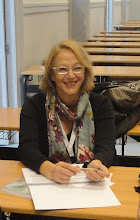The Empire State Building is one of the most iconic buildings and one
of the symbols of New York City.
It’s
located in Midtown Manhattan, at the intersection between the 5th Av. and west
34th street. It was one of the first buildings I saw when I arrived in New York
City and I was amazed of its high, its architectural design and mostly of its
views from the observatories.
It was designed and constructed between 1929 and 1931, during the
Art Deco Period of design. But the architect, William F. Lamb from Shrebe, Lamb
and Harmon wanted to design a building that would stand out, so he decided to
design the building with four facades facing the street rather than one façade
that buildings usually have. It is possible to see the building and always the
façade of the Empire State from mostly all the different points of the City.
The building and its architectural design can be observed from
other observatories of the city, as the ‘Top of the Rock’ located in the 70th
floor of the Rockefeller Plaza. There is where the picture was taken and The Empire State Building appears behind me.
In 1945, the structural integrity of the building was tested when
a twin-engine B-25 bomber crashed into the 79th floor. Fourteen people were
tragically killed, but the building remained standing.
It was constructed where the first Waldorf Astoria Hotel was situated.
It was not well communicated in that time with public transportation, and just
the 25% of the offices were rented when the building was inaugurated; for that
reason it was referred as the ‘Empty State Building’. They started to earn more
money with the observatories than with the rents. There are two observatories,
in the 86th and 102th floors and you can take one of the seven
elevators or if you prefer, you can climb the 1860 stairs to arrive to the
platforms. The entrance prices for the observatories are 25$ for adults and 19$
for children to go to the 86th floor and an extra charge of 17$ to
go to the top, the 102th floor.
The Empire State observatory offers the most amazing views of New
York City, where you
 can see a view of
360º of the City, the Chrysler building, the downtown of Manhattan,
New Jersey, Rockefeller center and the rest of the skyscrapers in New York
City, and depending of the weather and the day, also the Statue of Liberty.
can see a view of
360º of the City, the Chrysler building, the downtown of Manhattan,
New Jersey, Rockefeller center and the rest of the skyscrapers in New York
City, and depending of the weather and the day, also the Statue of Liberty.
The Empire state building has appeared in almost 90 movies, as
‘when Harry met Sally’, ‘An Affair to remember’, ‘Annie Hall’ or ‘King Kong’
which has one of the most famous moments, when King Kong finds Ann and climbs
into the top of the building where is surrounded by plane that made King Kong
fall down and die.
And also has been visited by more than seventy
million people, some of them famous people as Penelope Cruz, Pierce Brosnan,
Mary J. Blige, Fidel Castro or the Queen Elisabeth II.
One of the most interesting things about the Empire State Building
is that the top is always illuminated depending of the events, important dates
or seasons, such as Christmas, Saint Valentine’s day or Independence day.
October 8 Red/White/Green Columbus Day
September 11 Red/White/Blue In
memory of September 11
July 3 - 4 Red / White / Blue Independence Day
North/South Sides Blue/White/Blue Yankees colors
East/West Sides Blue/Orange/Blue Mets colors
March 16 - 18 Green
/ Green / Green In
honor of St. Patrick's Day
January 16 Red
/ Black / Green In honor of Dr. Martin Luther King, Jr. Day
November 23 - 27 Red /
Orange / Yellow In
celebration of Thanksgiving
November 11 - 13 Red /
White / Blue In honor of Veteran's Day
July 12 2010 Red/Yellow/Red Spain
won the World Cup
Video of the construction of the Empire State Building between 1939-1931 in New York City.
 can see a view of
360º of the City, the Chrysler building, the downtown of Manhattan,
New Jersey, Rockefeller center and the rest of the skyscrapers in New York
City, and depending of the weather and the day, also the Statue of Liberty.
can see a view of
360º of the City, the Chrysler building, the downtown of Manhattan,
New Jersey, Rockefeller center and the rest of the skyscrapers in New York
City, and depending of the weather and the day, also the Statue of Liberty.




















